Electric Water Heaters
Water Heater Element Testing
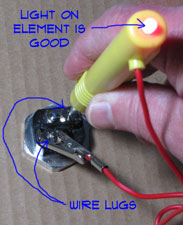 When you don't have hot water your elements may be at fault. Electric water heater element testing is one way to determine if one or both of them are bad.
When you don't have hot water your elements may be at fault. Electric water heater element testing is one way to determine if one or both of them are bad.
For a typical electric water heater you have four items that may have failed. Any one of them can cause you to have less hot water or no hot water. The first thing to check is the elements themselves. There are two simple tests that can tell you if they are bad. See the articles, 'Testing Water Heater Elements for Continuity' and 'Testing Water Heater Elements for Ground'.
The other common item is the thermostats. There are two of them, see the article 'Testing Electric Water Heater Thermostats' for a discussion and instructions on checking them.
How Water Heater Elements Work
Most electric hot water heaters have two elements. One or both of them could go bad. In addition there is a thermostat for each one.
If the thermostats go bad the elements won't heat up. Is this something you can do? The answer is probably yes. A couple of testers and a few precautions and you are all set.
There are a couple of simple test that you can perform to find out where the problem is. An element tester or multi meter and a voltage tester are all that you need.
Water Heater Element Testing - Information
What Can You Save?
New elements are around $10 to $20 each. A serviceman will likely change them if he comes out. The bill will be $225 to $275. About two hundred of that will be for the installation. Finding out what you need first is a good idea.
How Hard Could It Be?
Water heater element testing is not that hard, you just need a few testers.
Check the Simple Things!
Check the circuit breaker first. Make sure the it has not tripped. Each thermostat has a reset button (Well, not always, the lower one may not have one). You have to remove the covers and shut the power off to reset them.
What Can Go Wrong?
Only perform water heater element testing when the power is off. Electric hot water heaters have powerful current in them. You can be seriously hurt or even killed from a shock. Make sure the power is off. In addition, the current can ruin the testers.
Checking for Power
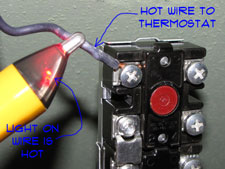 Checking for water heater power is a must on an electric hot water heater. Unlike a gas hot water heater, an electric unit will not work when the power is off.
Checking for water heater power is a must on an electric hot water heater. Unlike a gas hot water heater, an electric unit will not work when the power is off.
The first obvious thing you want to check is the breaker. The electric water heater should be on a dedicated two pole circuit in your breaker box. See if it has tripped. No power, no hot water. If the breaker has not tripped you will want to see if you have power at the hot water heater. Shut the breaker off for the hot water heater.
Remove the covers for the upper element and thermostat. Remove the insulation and protective cover. The two hot wires should be at the top of the thermostat. Turn the power back on and carefully use a non contact tester to check for power. Make sure the tester is working on something that you know is working. Do you have power? Then it is time to check the elements.
WARNING!! Make Sure the Power is OFF!!! BEFORE You Work on Electrical Devices!!!
Troubleshooting Water Heater Element Issues
The only way to tell if a heating element is bad is to test it. The article, 'Testing Water Heater Elements' covers this subject and you can review it by following this link.
A grounded element will not work, even if the element itself is good. To find out if the element is grounded in the article 'Checking for Grounded Heating Elements'.
The thermostats control the elements and the upper thermostat also controls the lower one. This article on 'Testing Water Heater Thermostats' gave you the information you need.
Electric Hot Water Heater Startup
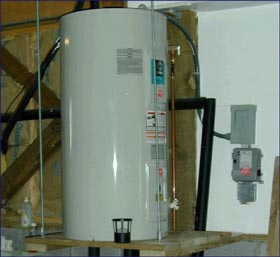 There are a few steps you want to follow for an electric hot water heater startup. Turning the breaker or water on prematurely can cause problems and may ruin the heating elements.
There are a few steps you want to follow for an electric hot water heater startup. Turning the breaker or water on prematurely can cause problems and may ruin the heating elements.
Not sure if you are in the right place? See the articles 'Troubleshooting Electric Water Heaters' and 'Gas Water Heater Troubleshooting' for a listing of all the water heater topics.
There are several repairs that on an electric water heater that require you to partially or completely drain the water out of the tank. The procedure below assumes that the tank has been drained.
If you did not drain the tank, but shut the water off, you still want to follow the procedure for turning on the water, to make sure the tank is full before the power is turned on. If only the power was turned off, follow the electrical segmetn below.
Close the Drain Valve
Close the drain valve at the bottom of the tank. Remove the hose that you used to drain the tank and clean up any excess water. Make sure the drain valve is tight.
Dry off the area around the valve and the valve itself. You are going to want to watch when the water is turned on, to make sure it is not leaking.
Turn On the Cold Water Supply
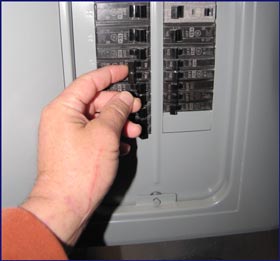 Shut off any of the valves or faucets in the house that you may have opened when you drained the tank.
Shut off any of the valves or faucets in the house that you may have opened when you drained the tank.
Turn the cold water supply line at the top of the tank. You should be able to hear the tank filling at this point.
There should not be a valve on the hot water side of the tank. If there is, make sure that it is open.
Wait for the water heater to completely fill with water. Try a couple of the faucets and bleed out the air to make sure the tank is full.
Turn On the Power
Hopefully, you followed a safe procedure for shutting off the power and 'tagged' or 'locked out' the breaker for the water heater. This is a good practice whenever you work on anything with electricity in your home. See the article 'Shutting Down an Electric Water Heater' and 'Electrical Safety at Home' for more information.
Turn the breaker on for the hot water tank after the tank is filled with water. It will take a while for the water to warm up after it has been completely drained down. Only one element heats at a time and it may take a while for the water to heat back up completely.
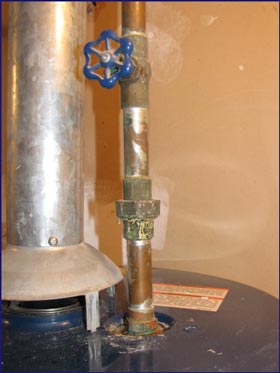 You should be able to hear a humming noise when the elements are heating. This will let you know that the water heater is working. After an hour, you should have warm if not hot water.
You should be able to hear a humming noise when the elements are heating. This will let you know that the water heater is working. After an hour, you should have warm if not hot water.
Summary
This article has given you the steps that should be followed when you restart an electric water heate after it has been shut down. Turning the power back on too soon can damage the elements, avoid problems and follow the steps.
Water Heater Element Replacement
This article covers the steps involved with installing hot water heater elements. At this point you should have determined that your elements are bad. If not, you need to see the article on 'Testing Electric Hot Water Heater Elements', for information on how to check them.
Not sure if the elements are your problem? See the article on 'Troubleshooting for Electric Water Heaters' or 'Gas Hot Water Heater Troubleshooting' to find a complete listing of water heater problems and the associated information that will provide solutions.
To install a hot water heating element you need to first, 'purchase the correct elements'. Second, you will have to 'shut down' and and 'drain your water heater'.
Once you have the correct parts and the water heater prepared, you will need to remove the old elements and install the new ones. This article covers the last two steps in this process.
Shutting Down the Water Heater
You can not work on the the heating elements until you have shut down the power to the water heater and drained the tank. The water inside your tank is hot and can scald or burn your skin. In addition, the electrical current that is used to heat the water can injure or even kill you.
Before you begin, review the article on 'Shutting Down and Electric Hot Water Tank'. This article gives you the step by step procedure that you need to follow.
Removing the Old Water Heater Elements
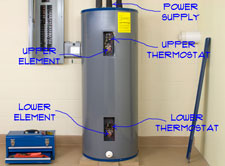 Now you have to get to the elements. Remove the two covers on the side of the hot water tank. There may be some batt insulation covering the elements. Push it back out of the way. You should see the thermostat, reset button and elements.
Now you have to get to the elements. Remove the two covers on the side of the hot water tank. There may be some batt insulation covering the elements. Push it back out of the way. You should see the thermostat, reset button and elements.
The element should have two wires hooked to it. It should not matter which way they are hooked up, both of them are hot leads (120 volts each to give you 240 volts total). Double check the leads with the tester, remember, no power. Unhook the leads, tag them if you want to. Push the wire to the side. In fact put a couple of wire nuts on them while you are working on it.
Most hot water heater elements on newer models are a screw in type. You need a large socket wrench for this type. They sell a special wrench for $7 or $8 dollars. You may not have an 1 1/2" socket wrench. Does your neighbor have one? Use a socket wrench or buy to wrench. Don't try to get them out with channel locks. Breaking it will be a big problem.
The other type of element has a flange with four bolts on it. Again you will use a socket wrench to remove it. Not rocket science here, remove the bolts and presto, the element comes out.
With your elements out you are ready to do one of two things. Get new ones to replace them. The other would be to clean the scale off of the ones you have and re-install them. You can clean the scale off the elements with a wire brush in the sink. Be careful not to damage them. Remove the rust and build up off the heating surfaces. Let them dry before you install them.
Getting the old one out was most of the work. Now the easy part.
Installing New Water Heater Elements
Installing Screw Type Elements
This is the easiest element to install. The opening in the side of the tank is threaded to match the element. Your going to need the socket wrench that you used to remove the old element and some pipe dope.
Use some pipe dope on a threaded hot water heater element. Screw it in by hand at first, making sure not to cross thread it. Once you are sure that it is threading in correctly, you can use the 1 1/2" socket wrench to tighten it. Make sure the element is tight.
Installing Flanged Elements
A flanged water heating element is held in place with four bolts. These are usually found on older water heaters. Clean the area where the flange goes to get a good seal.
Insert the element into the hole and start the four bolts into the holes. Tighten them down evenly
Using a Flanged Adapter Kit
Did you get a kit for a flanged element? Follow the instructions that come with the kit. A flanged element will have a gasket on it that you need to get aligned properly. Clean the area around the opening first to make sure you get a good seal. Tighten up the bolts on the element with the socket wrenches.
Hook Up the wiring
After the elements are installed you can attach the wires. It does not matter which terminal each wire is attached, both of them are hot leads. You have two wires for each element. Make sure the terminals are tight.
Starting the Hot Water Heater Up
Do not turn the power back on until the water tank is filled with water. See the instructions in the article 'Turning On a Hot Water Heater' for the procedure that should be followed.
Turning on the power before the tank is filled can damage the heating elements. This would not be good news for a brand new set of heating elements.
Checking For Leaks
After the water has heated up, check the elements for leaks. Shut the power back off before you do this. If there are no leaks, you can replace the cover plates and turn the power back on.
Purchasing Hot Water Heater Elements
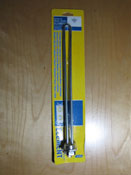 The wattage should be marked on the old element. It is a good idea to take it to the parts store when you get the replacement. There are both 'high density' and 'low density' hot water heater elements. Low density elements are considered better, they last longer and are less prone to build up. The low density elements have more surface area and therefore do not need to get as hot.
The wattage should be marked on the old element. It is a good idea to take it to the parts store when you get the replacement. There are both 'high density' and 'low density' hot water heater elements. Low density elements are considered better, they last longer and are less prone to build up. The low density elements have more surface area and therefore do not need to get as hot.
Types of Hot Water Heater Elements
There are three types of hot water heater elements, 'Low Density' and 'High Density' and 'Extra Low Density'. Density has to do with the surface are of the heating element. Low density elements have more surface area. They are also coated and/or made from different materials to resist corrosion.
Low Density Elements
This type of element is made from copper with a magnesium oxide and nickel coating. This type of element provides more heating surface and is less prone to corrosion. Low density elements are a little more expensive than high density types. This style will have a screw type fitting to install it.
High Density Elements
This type is the least expensive and will likely be he type installed originally in your water heater. This type will come in either a screw type or flange type connection. High density elements are the most suceptible to corrosion and failure due to the high heat generated. This type is made from copper and may have a zinc coating.
Extra Low Density Elements
This type is the best element that you can get. Some of them come with a lifetime gaurantee. They are made from high grade stainless steel. They are less prone to build up and will not burn out. These are also the most expensive elements.
You may have trouble finding a low density element with a flange assembly. You can purchase an adapter kit to use a screw in type on a flanged set up. It's up to you. For a screw type element you should not have a problem finding either density. Of course the low density elements cost more. Did you think you would get something for nothing? It's not a lot, a few dollars more for the better one. Make your choice on the density thing, use the salesman in you need to. After that you are ready to get things back together.
Wattage
The wattage on hot water heater elements can range from 1500 to 5500 watts. You want to get elements that closely match the wattage you have on your hot water heater.
Shutting Down an Electric Water Heater
 This article primarily deals with shutting down an electric water heater. Failure to follow the proper steps may result in damage to the internal elements of the water tank. There are only a handful of steps and they are easy to follow.
This article primarily deals with shutting down an electric water heater. Failure to follow the proper steps may result in damage to the internal elements of the water tank. There are only a handful of steps and they are easy to follow.
In most homes you have one of two types of water heaters, gas and electric. See the section below that explains how to identify what type of water heater you have. For the purposes of this discussion, propane would also be considered gas.
If you have an electric hot water heater, see the article 'How To Shut Down an Electric Hot Water Heater' for instructions on this type of unit. Got other issues that you need to address?
There are two steps in shutting down an electric hot water tank. First you want to shut down the power. Never attempt any repair on an electric hot water heater without turning off the power. Even removing the inspection covers can be dangerous.
Not sure if this is your problem? See the articles 'Electric Water Heater Troubleshooting' and 'Troubleshooting Gas Water Heaters' for a complete listing of all the water heater topics.
Identifying Water Heater Types
How To Identify an Electric Water Heater
Electric Water Heater Power Supply
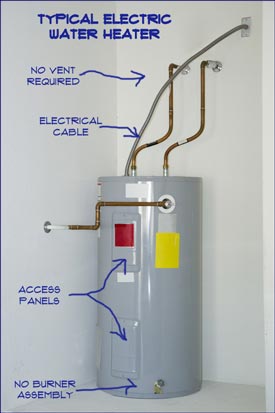 The first and perhaps easiest way to identify an electric water heater is the electrical cable that comes into the top of the tank. This cable could be a metal conduit, a flexible metal cable or even a plastic sheathed romex. Most of the time, this cable will come into the top of the unit, but it is possible for it to come into the side of the water heater.
The first and perhaps easiest way to identify an electric water heater is the electrical cable that comes into the top of the tank. This cable could be a metal conduit, a flexible metal cable or even a plastic sheathed romex. Most of the time, this cable will come into the top of the unit, but it is possible for it to come into the side of the water heater.
This is not to say that there are no types of gas water heaters that have electrical connections. Models with power vents will have an electrical connection. These are more expensive models and less common.
Lack of a Vent
Electric hot water heaters do not have vents. Vents are required on gas water heaters to remove toxic fumes. Electric water heaters do not generate fumes and therefore do not have a vent.
Vents can be made of metal or plastic and usually go into a chimney, metal vent pipe or through an outside wall. An electric water heater will only have the water inlets and a power cable at the top of the unit. NO VENT will be present.
Upper and Lower Access Panels
Electric hot water heaters use heating elements to heat the water. Most of them have two elements, an upper and a lower element. The elements are behind access panels on the side of the water heater. The spacing of these panels will vary, but usually one is near the bottom and the other can be anywhere from the middle of the water heater to near the top.
The panels may be a different color or the same color as the rest of the water heater housing. They are generally held in place by two screws and are easily removed.
A gas water will have a gas valve and burner access panel at the bottom of the water tank only. There will not be any access panels higher up on the housing.
No Gas Burner
An electric hot water heater uses internal heating elements and does not require a burner assembly. On a gas water heater the burner assembly is prominent at the bottom of the hot water heater
Not sure which kind you have? There are a couple of telltale signs that make it easy to identify which style you have. For an electric water heater, the wiring coming into the top of the water heater gives it away. Also, electric water heaters do not have vents, since they do not burn anything to heat up.
A gas water heater is identified by the vent at the top. This can be metal or plastic, depending on the efficiency level of your hot water heater. A gas water heater also has a gas line that attaches to the unit near the bottom.
No Gas Lines
An electric water heater will not have a gas line attached to the water heater. Gas lines are fairly heavy pipes that have large fittings on them. It is called black pipe, since it is black and oily when it is manufactured. The gas line connects at the bottom of the water tank at the gas valve. You will not see any of this on an electric water heater.
How To Identify a Gas Hot Water Heater
Burner Assembly
A telltale sign of a gas water heater is the gas valve and burner assembly at the bottom of the water heater. The gas valve will have a heavy metal gas pip attached to it. It will have a burner assembly below it that will be covered by a removable plate. This plate will protrude around the lower gas line and thermocouple connector.
It is usually possible to see a pilot light through a window after the outer cover plate is removed. Gas water heaters use a burner that has an open flame to heat the water.
Fume Vent at Top
Gas hot water heaters burn natural (or propane) gas to heat the water. Burning fossil fuel produces harmful gases. Therefore, a gas hot water heater will always have a vent of some kind.
The type of vent depends on the efficiency of the hot water heater. Higher efficiency units will use a plastic pipe the vent through an outside wall. Lower efficiency unit will vent into a masonry or metal chimney. Electric water heaters will not have any type of venting apparatus.
Gas Lines
Of course it stands to reason that that a gas hot water heater would use natural or propane gas to operate. This type of gas is a low pressure fuel that requires a fairly large piping system for delivery.
The burner assembly mentioned above will need piping connected to it. This piping will be obvious when you look at the water heater. It will be attached to the gas valve at the bottom of the unit and usually be connected on the left side when you are facing the water heater.
Shutting Down an Electric Water Heater
There are five steps to properly shutting down an electric hot water heater:
(1) Shut off the power to the water heater.
(2) Tag the breaker so that no one turns the power back on while you are working on the water heater.
(3) Cool down the water inside of the tank.
(4) Shut off the cold water supply to the hot water tank.
(5) Open a hot water faucet somewhere, (preferably above) in the house.
Step One - Turning Off a Water Heater Breaker
Most water heaters will have a two pole breaker. This breaker should be marked in your panel. It will usually be between 30 and 50 amps.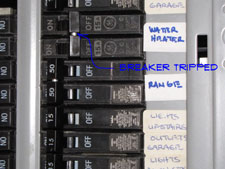
Turn off the power at the breaker panel. Don't be satisfied with just shutting it off. If you have lock out lugs for your breakers, you can put one on it.
Another option would be to tape it and mark the tape so that no one turns it back on. As a further precaution you can let everyone in the house no you are working on the electric. Tell them not to touch the service panel.
One final check. Use a voltage tester (a non contact voltage tester will work good) to make sure nothing is hot inside the covers when you open them up. It is not worth getting shocked or hurt when you are replacing a hot water heater element.
WARNING!! Make Sure the Power is OFF!!! BEFORE You Work on Electrical Devices!!!
Step Two - Tag the Breaker
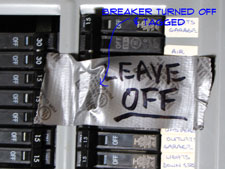 Safety standards for large buildings and construction projects call for a 'lock out - tag out' procedure to be in place whenever something the could cause physical harm. When electrical circuits are worked on, they need to be locked off and tagged to let anyone who has access to the panel know that the circuit is being worked on.
Safety standards for large buildings and construction projects call for a 'lock out - tag out' procedure to be in place whenever something the could cause physical harm. When electrical circuits are worked on, they need to be locked off and tagged to let anyone who has access to the panel know that the circuit is being worked on.
In a home, these restrictive protocols are not in place. However, a safety conscious person will want to take similar precautions. Shutting off a breaker is not enough, some sort of restriction and identification should be put on the breaker to let anyone know that the circuit is being worked on. OSHA has guidelines on this, however, every situation is different and it is the responsibility of the person or contractor doing the work to make sure safety precautions are followed.
This is no laughing matter, the current that goes to a water heater can kill you. Take steps to prevent the breaker from being inadvertently turned on.
This is another safety precaution. Use some tape over the turned off breaker at the panel. Mark on it, 'Do Not Turn On' in magic marker on the tape. This will stop someone from inadvertently turning the power back on while you are working on it.
Step Three - Cooling the Hot Water
For many repairs, you are going to want to cool off the water before you attempt to work on the tank. With the power off, the water will no longer be heated, even when the temperature drops.
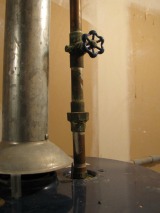 To cool the water temperature off, turn on a hot faucet in one of the sinks, do not add any cold water to it, let it run full hot. Let the water run until it feels luke warm. If the water coming out is warm to the touch it will be safe for working on the tank.
To cool the water temperature off, turn on a hot faucet in one of the sinks, do not add any cold water to it, let it run full hot. Let the water run until it feels luke warm. If the water coming out is warm to the touch it will be safe for working on the tank.
When you turn the hot water heater back on, it will take the normal recovery time for the water to heat back up. So give the tank an hour or so before you try to use it for anything that needs hot water, such as a shower or laundry.
Step Four - Shutting Off the Water
A properly installed hot water tank should not have a shut off valve on the hot water outlet side. This will prevent the tank from building up too much internal pressure. Shutting off the cold supply, is all that is needed when working on your hot water tank.
If you have two valves above your water heater, you will need to determine which one is the cold supply line. As you face the front of the tank, it should be the valve on the right side. This may not be fool proof, since the extra valve should not be there.
If you run some hot water, you can feel the pipes. The cold water supply line will be cool or cold. The hot water inlet will be warm after you run hot water through it.
Turn on the hot water in a faucet. You can tell by feeling the pipes, which one is the hot and cold. Tag the cold water valve so that you know which one it is to shut off. Wait until you have cooled the water down inside the tank to shut the water off.
Step Five - Draining a Hot Water Tank
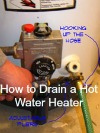 Some activities on an electric water heater can be done without draining the tank. Checking and testing the elements and thermostats can be done with the tank full. Adjusting and replacing the thermostats can also be done with the tank full. You can also check the power supply to the unit without draining it.
Some activities on an electric water heater can be done without draining the tank. Checking and testing the elements and thermostats can be done with the tank full. Adjusting and replacing the thermostats can also be done with the tank full. You can also check the power supply to the unit without draining it.
Replacing or removing the elements for any reason cannot be done with the tank full. You will have to cool the water and drain the tank before you can work on the elements.
You need to drain the tank if you are going to flush the sediment out. Regularly flushing sediment is important on electric water heaters. Sediment build up will damage the lower heating element, dramatically reducing the amount of hot water you will have.
This is a bit of a job in itself. See the article, 'Draining a Hot Water Heater', for information and instructions on how to empty the tank.
Where To Next?
After you have completed your repairs you are going to need to get your water heater working again. See the article, 'Starting Up a Hot Water Heater' for instructions. The steps are similar to shutting a water heater down, you just want to get them in the right order.


